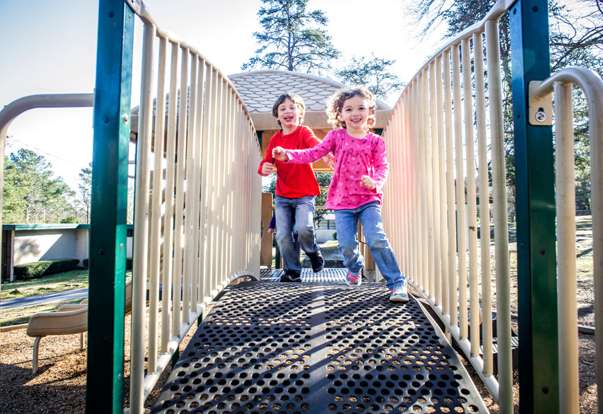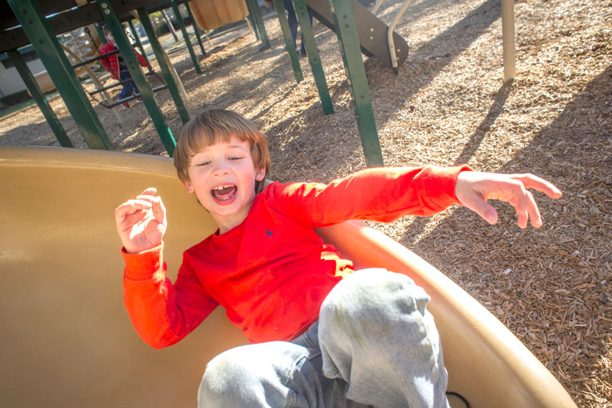
From UAB Magazine

Children’s play isn’t, well, child’s play. It’s a stepping stone to adulthood, says Laura K. Vogtle, professor and director of UAB’s Postprofessional Master’s Program in occupational therapy in the UAB School of Health Professions. Play helps to build brains, bodies and social interactions that prepare children for school and the rest of their lives.
Play also is a key topic in the Occupations of Infants, Children and Adolescents course, which Vogtle teaches with Sarah C. Tucker, assistant professor in UAB’s Department of Occupational Therapy.
In class, students discover the benefits that come with fun and frolicking. “Early on, children learn the properties of objects—what they feel and sound like—and how to play with other children,” Vogtle says. For older kids, “outdoor activities offer enjoyment and lead them into sports and other activities like gardening, walking a dog, and learning about friends and neighbors.”
But children today aren’t playing quite the same way as their parents did when they were young. Smartphones and other technology offer different kinds of diversions, and recess is on the chopping block at some schools. These changes present hurdles both for kids and the occupational therapists working to help them.
For example, children who don’t have frequent opportunities to play may experience slower growth rates, increased risk of health issues, and decreased social skills. Vogtle cites studies by early childhood expert Burton L. White in which children born in prison who stay with their mother’s experience significant delays due to environmental deprivation and lack of play and social engagement. Tucker says other studies have shown that children in orphanages without access to a nurturing sense of play have difficulty later in life tolerating different environments.
“When children have some type of challenge that impacts their ability to engage in play, then you see a ripple effect in many areas of their lives,” Tucker says.
Growth challenges
Many people expect children to know how to play naturally, says third-year occupational therapy master’s student Keaira Gunn, of Fairfield, Ala. But “this is not always the case, particularly with atypical children,” she says. Early intervention—from birth to three years of age—may be a solution. Occupational therapists take a comprehensive approach, factoring in the child’s environment, family dynamic, and economic situation. Then they can educate families and teachers about fostering play at home, at school, or in the community; help modify play environments; and adapt toys for a child’s specific needs and skill level.
“We recommend activities that challenge children and help them improve in areas where they may be lacking without overwhelming them with tasks that are too difficult,” says Gunn, who recently conducted clinical work with United Cerebral Palsy’s Hand in Hand program. “Play should encompass physical activity, as well as the child’s mental and emotional state and cognitive action.”
Activities and toys don’t need to be expensive, but they should be age appropriate and engaging, says Amanda Bearden, another third-year student, from Pelham, Ala. “For example, a toddler can learn and practice fine motor skills through something as simple as stacking blocks,” Bearden explains. For older children, more complex play activities help them learn what is socially appropriate through peer responses, she adds.
“It is important to offer play opportunities that encourage taking turns and solving problems,” notes Adrianne Smiley, a third-year master’s student from Lithonia, Ga. These activities also help children “integrate their senses and body systems to understand phenomena such as cause and effect and danger.”

Technology and time
The difference between play today and 20 years ago is dramatic, Vogtle says. “Now it’s difficult to separate children from technology,” including television, computers, and video games, she explains. “We often see families outdoors, and the child is still watching a video on a phone. It takes more effort to get them out and engaged in other things.”
Children also seem to have less playtime, with many schools reducing or even eliminating physical education and recess, Tucker says. Some kids may be limited due to economic or environmental factors, including places where it’s not safe — due to increased violence or other dangers — to play outside the home without supervision.
Outdoor play is critical, say Vogtle, Tucker, and the students. Kicking a ball, riding a bike, or climbing monkey bars, for example, can help children develop gross motor abilities in their arms and legs, notes third-year master’s student Catherine Stubbs, a Greenville, Miss., native who completed clinical work with Children’s Healthcare of Atlanta. These activities also can improve physical coordination and strength and help reduce the risk of childhood obesity.
Just as important, however, are the sensory experiences of being outside. “Children need the opportunity to explore, experiment, manipulate, influence, change, discover, practice, push their limits, and create,” Stubbs says.
Fortunately, communities seem to have become more aware of the importance of outdoor play, developing new parks and structured recreation areas, Vogtle says. Organized play, such as soccer and softball, also can help children mentally, physically, and socially — though too much of a good thing could be problematic. An increase in the number of organized after-school activities—and the hurried, overscheduled lifestyle that can result — can actually decrease the free, child-driven play that is so beneficial, Stubbs notes.
Having fun, helping others
As a child, Gunn enjoyed riding her bike and playing games such as tag and hide-and-seek. “I was just having fun,” she says. “I didn’t think of it as helping me physically, socially, or emotionally. For children today, it can be difficult to get that experience.”
Now, building outdoor time into a schedule is something Gunn emphasizes in her fieldwork, an experience that has deepened her commitment to occupational therapy. “It gives a better sense of how our work helps others,” she says. “We are making a difference.”




